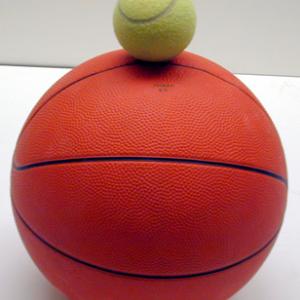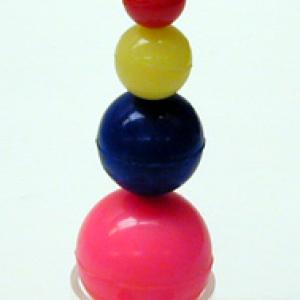College of Liberal Arts & Sciences
1N30.60 - Tennis Ball and Basketball
Practice will be required so that the basketball and the tennis ball can be dropped simultaneously so that the tennis ball stays on top of the basketball.
Lube the stem of the Astro-BlasterTM with some WD-40. When dropping try and make sure that when it hits the ground the stem is pointed straight up.
NOTE: Safety glasses should be worn to protect the eyes of the dropper.
- Paul Hewitt, "Answer to the November 2018 Figuring Physics", TPT, Vol. 56, #9, Dec. 2018, p. 651.
- Dan MacIsaac, "Dropping a Tennis Ball on a Basketball: Rhett Allain’s Coding Models of Collisions", TPT, Vol. 56, #8, Nov. 2018, p. 573.
- Iain MacInnes, "Debouncing a Superball", TPT, Vol. 45, #5, May 2007, p. 304.
- Ernie McFarland and Tom Kehn, "The Fantastic Physics Fun Show", TPT, Vol. 34, #8, Nov. 1996, p. 512.
- Alan W. Hirshfeld, "Bigger Bounces", TPT, Vol. 33, #8, Dec. 1995, p. 548.
- John D. McGervey, "Hands-On Physics for Less Than a Dollar Per Hand", TPT, Vol. 33, #4, Apr. 1995, p. 238.
- Herbert R. Bailey, "Experiments on Free Fall and Rebound", TPT, Vol. 28, #2, Feb. 1990, p. 100.
- D. Rae Carpenter Jr., Daivd J. Rehbein, and Robert J. Bonometti, "BanTM Deodorant Ball Mortar", TPT, Vol. 26, #8, Nov. 1988, p. 522.
- G. Stroink, "Superball Problem", TPT, Vol. 21, #7, Oct. 1983, p. 466.
- Rod Cross, "Vertical Bounce of Two Vertically Aligned Balls", AJP, Vol. 75, #11, Nov. 2007, p. 1009.
- S. Redner, "A Billiard-Theoretic Approach to Elementary One-Dimensional Elastic Collisions", AJP, Vol. 72, #12, Dec. 2004, p. 1492.
- Ian Bruce, "A One-Dimensional Collision Experiment", AJP, Vol. 58, #7, July 1990, p. 696.
- Joseph L. Spradley, "Velocity Amplification in Vertical Collisions", AJP, Vol. 55, #2, Feb 1987, p. 183.
- Walter Roy Mellen, "Superball Rebound Projectiles", AJP, Vol. 36, #9, Sept. 1968, p. 845.
- Jearl Walker, "The Amateur Scientist: Drop Two Stacked Balls From Waist Height; the Top Ball May Bounce Up to the Ceiling", Scientific American, Vol. 259, #4, Oct. 1988, p. 140.
- "M-595. Bouncing Balls-BAN Ball Mortar", DICK and RAE Physics Demo Notebook, 1993.
- "Frozen Bounce", 50 Fun Experiments for the Mad Scientist in You, National Geographic Kids, p. 115.
- Pat Murphy, Ellen Macaulay, and the staff of the Exploratorium, "Ball Buddies", Exploratopia, p. 143.
- Vicki Cobb and Kathy Darling, "Follow the Bouncing Ball Point", Bet You Can't!.
- Borislaw Bilash II and David Maiullo, "Bounce It Up", A Demo a Day: A Year of Physics Demonstrations, p. 103.
- Jearl Walker, "1.44. A Crashing Demonstration", The Flying Circus of Physics Ed. 2, p. 22.
- Jearl Walker, "1.43. Dropping a Stack of Balls", The Flying Circus of Physics Ed. 2, p. 21.
- Jearl Walker, "2.18. The Superball as a Deadly Weapon", The Flying Circus of Physics with Answers.
- Robert L. Wild, "152. Conservation of Momentum with Superballs and Ballpoint", Low-Cost Physics Demonstrations, p. 35.
- Cunningham and Herr, "5.2.4. Conservation of Energy", Hands-On Physics Activities with Real Life Applications, p. 290.
- Christopher P. Jargodzki and Franklin Potter, "247. Velocity Amplification", Mad About Physics, p. 98, 237.
- Robert Ehrlich, "E. 6. Dropping a Small Ball on Top of a Big Ball", Turning the World Inside Out and 174 Other Simple Physics Demonstrations, p. 60 - 62.
- Margaret D. Campbell, "Superball Collisions", Website Paper.
- Wayne D. Peterson, "Velocity Amplifier Using Stacked Disks", Brigham Young University, 1999 AAPT Apparatus Competition.
- "Multiple Ball Drop", Physics From the Junk Drawer, 3rd Edition, The Science House, North Carolina State University, p. 26.
- Bobby Mercer, "Ball Blaster", Junk Drawer Physics, p. 42.
- Tik L. Liem, "How High Will The Ball Bounce?", Invitations to Science Inquiry - Supplement to 1st and 2nd Ed. p. 137.
Disclaimer: These demonstrations are provided only for illustrative use by persons affiliated with The University of Iowa and only under the direction of a trained instructor or physicist. The University of Iowa is not responsible for demonstrations performed by those using their own equipment or who choose to use this reference material for their own purpose. The demonstrations included here are within the public domain and can be found in materials contained in libraries, bookstores, and through electronic sources. Performing all or any portion of any of these demonstrations, with or without revisions not depicted here entails inherent risks. These risks include, without limitation, bodily injury (and possibly death), including risks to health that may be temporary or permanent and that may exacerbate a pre-existing medical condition; and property loss or damage. Anyone performing any part of these demonstrations, even with revisions, knowingly and voluntarily assumes all risks associated with them.

